“De Aanslag” (The Assault)
“These evocative images only sharpen a set of questions of which their photographers seemed oblivious. If the medic was sensitive enough to capture the soul of an elderly fisherman, how could he not see in that man’s eyes a hint that the army he was part of had just captured a nation? How could someone who took such dramatic pictures with sensitivity and a measure of respect have forgotten who he himself was in that moment? Perhaps this is why I had a sense that my curiosity about the points of view evident in German soldiers’ snapshots could lead me into dangerous places. In the expressive photo of the barges at Rotterdam, and of the old man in Marken, the photographers are absent. You, the viewer, are invited to take their place. . . . You are invited to forget who you are as you look. And here is where things begin to go dark.”—Dr. William Ramp
Small Things Recollected
By Dr. William Ramp
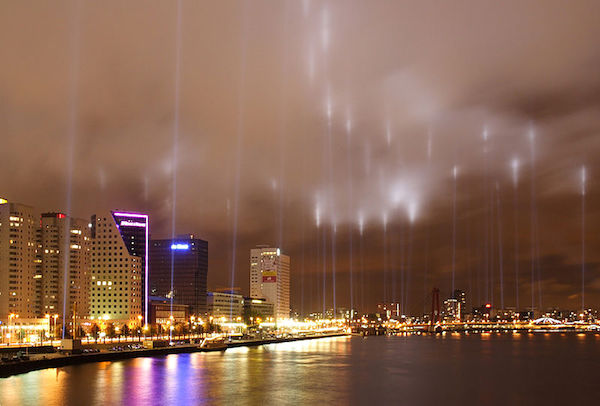
Unpünktlichkeit, Vorzeitigkeit, Verfrühtheit, and Verspätung
LETHBRIDGE, ALBERTA Canada—(Weekly Hubris)—1 August 2021—I spent the first year of the COVID pandemic thinking that I could and would come up with some big insight about it to turn into a column or series of columns for Weekly Hubris. Instead, my writerly voice went mute.
If I became more isolated, I was already well-practiced in solitude. In recent years, I’ve floundered through some painful personal failures and a few political and professional defeats. The astringent self-questioning that resulted left me disillusioned, ashamed, confused, and little-inclined to company. COVID social restrictions did end up affecting me, but as usual I was the last to know.
My occupation lends itself seamlessly to online labor at home and alone. But adult ADHD made self-organization in a social vacuum a nightmare. Online teaching easily doubled my workload. I was intimidated by the technology; could not put details into perspective; had trouble with sequencing and time-management; could not substitute for the external cues given in face-to-face-interaction. Without immediate interpersonal reward (or rebuke), I fell into an intimidated paralysis and confusion: a mix of brain fog, writer’s block, lack of perspective, panic, and self-admonishment.
I’m told I come across in person as very centered, but my centers were often external, and as they dematerialized during the pandemic, I fell out of touch with myself as well as others. Ironically, the more alone I felt, the more I wanted to be alone. I developed a terror of the phone. The closer my friends, the more I shied away from opportunities to connect with them. I couldn’t bear to look at my unread email messages. I lost track of promises and commitments; of the days of the week. Social media became my main interactive outlet, until one day for no discernable reason it ceased to serve. I rarely went outdoors. I fell out of synchrony; out of time, suffering a quadruple infection of Unpünktlichkeit, Vorzeitigkeit, Verfrühtheit, Verspätung.
I did cling to a remnant impulse to check the news. But recently, I’ve more often traveled back in time; my own, and the times of those I’ve known. I have plenty of prompts: a few thousand books, cabinets of documents and photos; records of all kinds. I suppose that this is what it is to get old. Against the recurring shock of the social-mediated “new,” one begins to dissociate temporally; returning with an occasional story for others, only to see their eyes slide aside above indulgent behind-the-mask smiles. Here we go again.
What is the time? What is now, and then, and how do they interpenetrate? What is your time?
The inability to leave a past moment behind; to repeat and repeat the experience of and response to that moment, is a feature of trauma. In first-person trauma, this is involuntary; one does not wish nor choose it; nor does one know when it will next hit. Is there such a thing as a second-hand, physically-distanced trauma at work in those who choose obsessively to return to some past moment?
All is not so bad: I’ve engaged in two activities that the news tells me many others have taken up: pursuing a hobby and buying things online. I am praised indulgently, for the first; it gives purpose a little shot in the arm as one’s career approaches its end. But the second trips an internal warning buzzer. (Buzzers!! Tiny icons of power and secrecy in the detective novels and political thrillers of the 1930s: have they quietly gone extinct, replaced by electronic beeps and screen icons?) It signals what I know too well about my financial habits.
My first online purchases left me with a collection of obsolete woodworking tools which I intended to restore or at least make displayable; removing rust and dirt, applying preservative, repairing. But leading up to the month of May, I began following online sales of historical photographs, post cards and ephemera, amassing a modest collection of old images of the Netherlands. And there starts my tale for this month.
Eighty-one Years to the Day
I must first give a disclaimer. I hold a PhD degree: it certifies competence in a quite specific “area of expertise.” It doesn’t grant me special status in general knowledge; nor does it make me any wiser, more moral, more perceptive or more mature in personality than anyone else. Josef Goebbels, the Nazi propaganda chief, held a doctorate. So did nine of 17 leaders of Einsatzgruppe A, an organization dedicated to exterminating the Jews, Roma, Sinti, Communists, and intellectuals of Lithuania, Latvia, and Estonia in World War Two. Three Einsatzgruppen were commanded by holders of doctorates, one of whom held a double doctorate.
I began this column innocently enough, partly out of curiosity, but the topic quickly tugged me into deeper water. My handling of it isn’t buoyed by professional competence. The dwindling few with lived experience of what I describe, and historians who specialize in occupied Europe during the Second World War, would likely spot that. If I offer a guide to the perplexed here, it’s only in the sense that I am one of the perplexed. I learned some things as I wrote, and un-learned others. I still have much more to learn. My words are footsteps of an uncertain pilgrim.
I began writing on 15 May 2021, 81 years to the day since General Henri Winkelman, Commander-in Chief of the Dutch army and air arm in Europe, received a message that General Georg von Kuchler, commander-in-chief of the invading German forces, was willing to meet him in the village of Rijsoord, ten miles southeast of the ruined and smoking hellscape of Rotterdam, to negotiate the terms of a written surrender.
Winkelman did go to Rijsoord that day, and he signed the capitulation of all Dutch forces in Europe, save for those Navy units which had escaped to Britain, Dutch troops still fighting in Zeeland on the Belgian border, and individual Dutch airmen who had crossed the Channel. Winkelman adamantly refused two of Kuchler’s demands: that Dutch pilots choosing to fight with British forces be classed as francs tireurs outside the laws of war (which meant they could be shot on sight), and that Winkelman himself declare that he would offer no personal resistance to German forces in the Netherlands. For the latter refusal, he was interned until the end of the war.
A House in Which Once Had Lived a Family
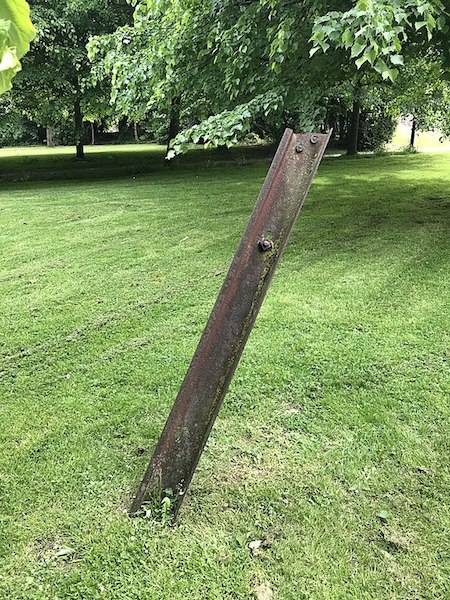
I was not alive when these events took place. All I know of the Second World War I’ve learned from books, articles, photographs, video and audio recordings, reminiscences and memoirs of those who lived through it, and my own witness to its scattered material remains. For example:
– A tram rail hurled aloft by a German bomb that spiked itself into the grounds of St. Mary Redcliffe Church in Bristol, where it remains to this day
– A small residential lot in the same city, still vacant when I saw it in the 1990s, on which once had stood a house in which once had lived a family, before the bomb hit.
– The remains of rifle pits, glimpsed briefly from a London commuter bus.
– Pockmarks from bomb-shrapnel in a wall near the South Kensington Museum.
– The bleak, open, Modernist heart of rebuilt Rotterdam.
– An enormous residue of rubble, carefully sorted on regiments of planks; slowly being reassembled in the fall of 2000 into the resurrected Frauenkirche of Dresden.
– City blocks cleared for reconstruction in downtown Dresden in the same year, punctuated by cellar stairs leading from nowhere to nowhere.
– Black-and white photographs of bombed cityscapes.
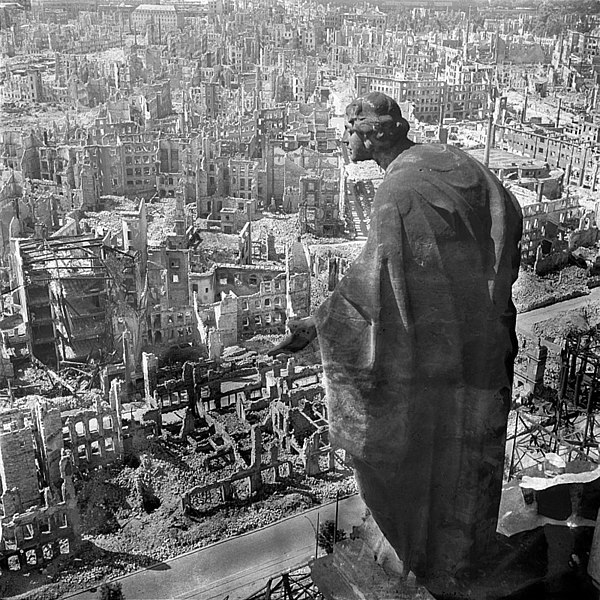
“Shugh,” He Said Softly
Yet even second-hand, these stories and experiences marked me. Every May, when others are preparing for Mother’s Day, I return in time to five days I never experienced personally; five days receding now into long ago; five days during which the Dutch army fought desperately and unsuccessfully to turn back a neighbor who had come calling violently, without notice.
My father, by contrast, did live through these events, and he wrote a small, privately-printed memoir about them in his later years. They were impressed on him so strongly that thereafter he could recall, minute by minute, the entire first day of the invasion. Not that he recalled it often. He never sat me down and took me through the May days. I learned about them as much by what he kept silent as by what he told; in the slight but evident shortness with which he answered some of my persistent questions, and by the occasional event that would knock him entirely out of the present and back to a singular moment in May,1940.
One of these happened when we were loading hay in a back field on our farm; he intent on getting as much of it as possible under cover before rain; me scratched by the dry stalks and sweating resentfully to keep up with him. Out of nowhere, two mottled olive and brown military jets swooped down and then up over our heads, one chasing the other, an ear-splitting 300 metres distant. Dad stopped stock-still, the hay forgotten, and gazed at the sky open-faced. “Shugh,” he said softly, disarmed and shocked out of himself. He shook his head wonderingly. “That was just like 1940.”
Later, I asked him to say more about what that day had been like in the air. He replied in a deprecating tone that there was little to tell: the Dutch had had only—what?—”about five airplanes,” after all.
The Fear and The Fascination
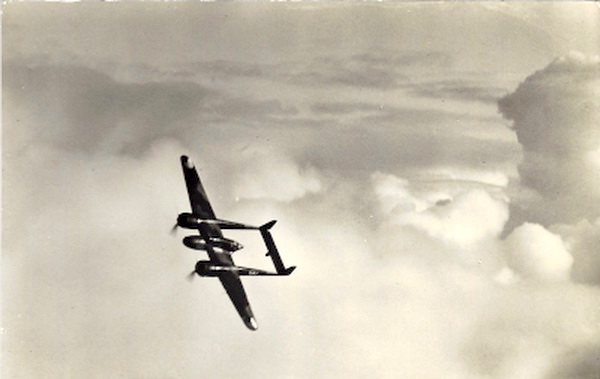
In his memoir, Dad casually referred to being tasked by his father on the chaotic morning of May 10 to go with a sister to make the regular morning deliveries along the family milk route. My grandfather provided them with tin pails to wear on their heads, but I was disconcerted that he would even ask them to go out. My surprise, when I voiced it, didn’t register with Dad. Another time, I asked him about a reference in the same memoir to random blasts that occurred during the invasion and on occasion thereafter. They must have startled him. I asked about their causes. “Well, you have to realize,” Dad said with a touch of irritation, “all the way through the war there would be explosions that would happen, and no one would know the reason. You got used to it.” I think I was also being told, “and you didn’t ask questions.”
In his old age, he watched the news about Donald Trump’s presidential campaign and 2016 win and warned me that he had seen it before and had a sense of where it could lead. Knowing that I was at the time politically involved, to a rather minor degree, and that my politics touched my writing, he warned me to be careful. He recalled a friend in the Resistance who had been killed by members of the Leiden Gestapo, trench-coated men carrying short-barreled shotguns who left shattered bodies on the street to be picked up with the garbage in the morning.
The period 1940-1945, frozen in the person of my father, provided a counterpoint to the privileges of middle-class peace and prosperity that I experienced growing up in the Canadian 1960s, as also did the nuclear stand-off of the Cold War. They helped raise me to a particular kind of adulthood. Of course, unlike my father, I did not have flashbacks generated by a direct experience of war. Still, I was and am easily transported back, year after year, to the May days as I have learned about them, and they continue to provide a touchstone for my relation to the present, stronger in fact each year.
The final lines of a poem by Nina Kossman capture something of this retrospective perpetuation, and of its source:
. . . he didn’t talk about the war,
yet his thoughts were passed on to me
like a silent memory,
and maybe that’s why sometimes I remember
things I never lived through myself.
Like the narrator in this poem, I’ve never been free of the fear and the fascination of war.
Schöne Zeit and Bevölkerung
When I started collecting old photographic images of Holland, certain of them began to exert a special fascination—snapshots taken between 1940 and 1945 by Germans; by the occupiers. For some reason, I was drawn to see Holland through their eyes, though I was unnerved by that, and tried to maintain a critical distance. I could imagine my Dad’s slight frown and short sigh of unvoiced concern, or the question of an uncle I’d been close to: “Why would you bother with the point of view of invaders or traitors?”
![Holland in the rain, through an Opel Blitz [truck] windscreen, May 1940.](https://weeklyhubris.com/wp-content/uploads/2021/07/Ramp-Holland-in-the-rain-through-an-Opel-Blitz-truck-windscreen-May-1940..jpg)
Practically speaking, this “bothering” was and is also a severely limited exercise. There are layers of pre-selection, commercial, ideological, and legal, that govern what ends up for sale online. What images did a veteran choose to keep in an album, and when were these albums compiled? (Many such photographs were developed and collated only years after the war’s end.) What prints or negatives did their heirs decide to keep, sell, or discard? What do dealers think are saleable, and what items do they shy away from as potentially generative of legal problems (especially in present-day Germany), or as not fitting some set of conscious or unconscious expectations? The photographs I’ve bought could never constitute a representative sample. What I can draw from them here is thus impressionistic.
But impressions, especially unnerving and startling ones, can nonetheless instruct. They can lead to different lines of thinking and historical research. This is so despite the fact that many of the images sold online have been torn from albums and the personal histories of their makers and owners with little or no attempt to preserve any sense of their relations, contexts, or provenance. They become atomized, floating representations of who knows what. But their freedom from a specific historical scaffolding paradoxically frees elements that otherwise might have been placed, in Derrida’s phrase, “under erasure.” They still have an impact and serve as indicators. They can also incite an array of interpretive options that say as much about us as about them.
Reading the cryptic notes sometimes found on the backs of the photos, and some of the better sellers’ descriptions, I began to learn a new vocabulary of military movement and of mechanized destruction: Vormarsch, Angriff, Einsatz, Zerstörte, brennende, geschossen, zerbombt, absturz, gesprengte Brücke, LKW, Flugzeugwrack. But also Rast, Tanz, trinken, Musik, Musikkonzert, am Strand, Mädchen, and more hauntingly, schöne Zeit, and Bevölkerung
After posting a few thoughts about these images on social media, I thought to collect them into a more extended discussion. That meant an extended sojourn in the past this spring, but it led to my return to Weekly Hubris this month.
If you wish, accompany me. It won’t be a nostalgic stroll. It will be tentative and incomplete as well as impressionistic. It will spool out over two or three installments. You might find yourself wanting to take it further. That’s OK. I’ll have my own questions along the way, including an initial query (to myself and perhaps to you): “What in hell are you doing here?” Eventually, I’ll suggest some possible answers that may be introspective but will also be political.
In this first column, I’ll set the stage, briefly retelling the bezetting, as the Dutch call the invasion and occupation and discussing some initial images, in ways that might seem at first a little detached or even naïve. I’ll end with an innocent-seeming question or two, to be taken up in a second or following columns. This innocence is part-real, part-staged. To quote Leonard Cohen, “You want it darker? We’ll kill the flame.”
He Was the Second World War
First, a couple of trivial coincidences. In his photographs, General Winkelman, signatory to the surrender 81 years ago, bore an uncanny resemblance in facial set and expression to certain images of my Dutch grandfather, a great-uncle, and a more distant ancestor on my grandmother’s side; a barge skipper who paid for a small carte de visite likeness of himself before beginning a voyage along rivers and canals that would lead him to, and perhaps through, the battlefields of the Franco-Prussian War.
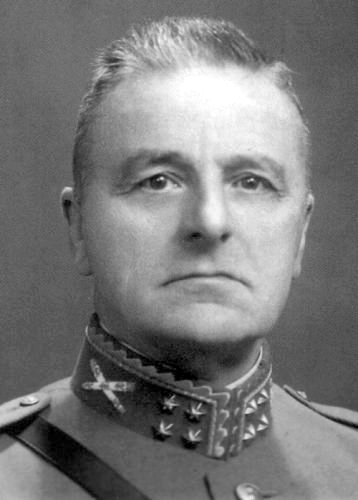
My title—De Aanslag (The Assault) is borrowed from a novel by Harry Kurt Viktor Mulisch, born in Haarlem, North-Holland on 29 July 1927. Two days later, on 31 July, my father startled to life, in a toll-keeper’s cottage and in a different social class, on the outskirts of Leiden—today, a mere 46 minutes from Haarlem via the A4 motorway. Mulisch’s father worked for a German bank which, during the occupation, dealt in confiscated Jewish assets. Harry and his mother, who was Jewish, were saved from deportation to a concentration camp by his father’s collaboration with the occupation authorities, though his maternal grandmother died in a camp. Of himself, Mulisch said that he didn’t just write about the Second World War; he was the Second World War. Mulisch’s book, available in English translation, is justly if uneasily celebrated for its unsparing examination of the occupation as national trauma, and of the aftermath as fraught national self-reckoning. It’s my touchstone for this and the next column.
My father’s parents survived the war thanks in part to the food they could grow on their own farm. They had no Jewish ancestry. They kept their heads down and did not become actively involved in political resistance. They did shelter overnight a young lawyer on the run from the police, and my grandfather may have provided some quiet aid to a brother who helped to hide a Jewish family known to him. But when one of his sons-in-law hinted at involvement in Resistance activities and brandished a pistol (behind closed curtains), he was disturbed and disapproving of the younger man’s lack of caution. After the war, he was called to serve on an inquiry into activities that had taken place during the occupation in a local institution for persons with mental handicaps. He returned from that duty badly shaken.
Its Significance Lies in Its Context
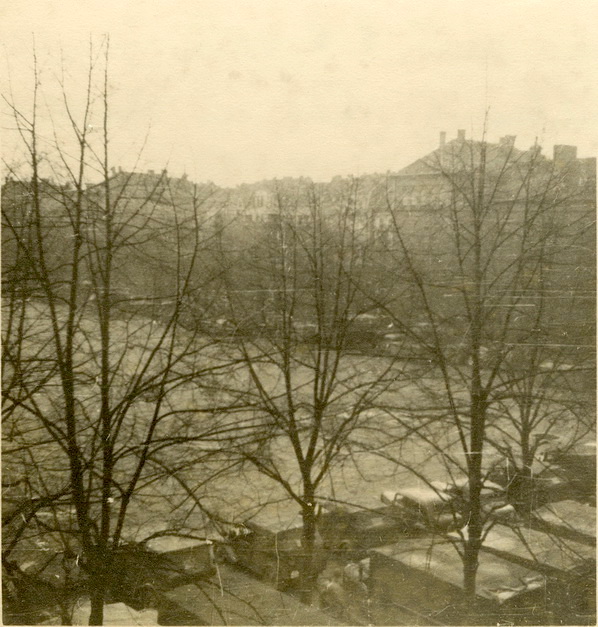
This is the first image by a German soldier that I bought. It is not a stand-out; it’s dim and muddy even after digital work. Its significance lies in its context, not the content.
At the time of the photo, it is late of a long Northern European spring evening, Thursday, 9 May 1940, probably after sunset; at about 21:30hrs. It depicts what seems to be a mundane parking lot but which is in fact a vehicle compound allotted to the First and Second Companies (foreground and background, respectively) of Intelligence Department 161, attached to the 61st Infantry Division of the Wehrmacht, stationed at Aachen, about 5 kilometers from the southern Dutch border.
Jakob Eichborn, a member of 2 Kompanie, has stopped to take a quick snapshot, probably with a cheap pocket camera, conscious of the significance of the moment. His unit has just received notice that 61. Div. will move that night toward the border, crossing in the predawn into the Dutch province of Limburg, and through it, on into Belgium. Likely, he will not sleep tonight.
Some 236 kilometers to the northwest, my father, not yet 13, is off to bed, anticipating an early start to farm chores. He does not know what Jakob Eichborn knows. But tomorrow, every minute of the waking day will be burnt into his memory by the thing that Eichborn knows, remaining intact there for almost 80 subsequent years.
It will be a triumphant march for Jakob Eichborn and his unit; something like an outing, during which many other soldiers will also take snapshots for friends and family. The Dutch Army that they will face initially on this western vormarsch has been weakened by years of interwar policy and funding neglect, and by the 19th-century thinking of an aristocratic general staff (Winkelman was parachuted in to replace its former head too late). They could not imagine that their fellow Heeren on the other side would breach the nobles’ code by invading without prior declaration.
The assault divisions and those who will follow after to garrison captive Holland are for the most part not elite troops, and their training and organization remain rather incomplete. Some units contain veterans of Poland; others are completely green. To the German general staff, the invasion of Holland, while admittedly a major operation, will be (as a postwar author will later dub it) a “sideshow to a sideshow”; a flank-covering operation for the main event: the Battle of France.
Some of those entering Holland on the morrow will be blooded in intense combat along the Grebbe-Peel-Raam defensive lines; at either end of the great Moerdijk bridges; in the watery western province of Zeeland; near the naval base on the Hook of Holland and the termini of the Afsluitdijk (the great seawall completed in 1932 that now separates the IJsselmeer from the North Sea). Others will die in horror as their Junkers transports plummet burning to earth; still others will be pinned down on airfields next to bogged-in planes by Dutch artillery and machine-gun fire. In these pockets of heavy fighting over ten days (the last Dutch troops were withdrawn from Zeeland on 19 May), about 2,300 Dutch military personnel will lose their lives, as will 2,200 Germans. About 7,000 will be wounded on each side. More than 3,000 Dutch civilians will also be killed.
Die Schöne Zeit
But very many of these young Germans will see little or no fighting at all until they reach Belgium or France, where the British and French have rushed in reinforcements that will never make it as far northeast as Holland. Those Wehrmacht troops lucky enough to pull occupation duty in the Netherlands for a year or two will remember it as die schöne Zeit; a magical interlude in which they could treat their brief stay as if they were tourists. They will snap pictures of their trucks, equipment, and comrades; of their installations and technical achievements; of themselves on the Scheveningen beach or drinking in pubs; of picturesque Dutch villages and villagers; of windmills and streetscapes. Some will pose, smiling, with children, girls, fishermen, restaurateurs, barkeeps, landladies, and concierges—and with those Dutch families who welcomed their presence. There were more than a few such families.
They will take pictures of visiting generals, identified on the back of cheap Velox and Agfa prints, as “Vati,” or “Papa.” Even the wasteland of central Rotterdam, flattened on 14 May by a wave of low-flying Heinkel HE-111 bombers, will become a popular photographic stop for awed young military tourists.
One unidentified young soldier, perhaps a mechanic, maybe a paratrooper, will pose on the wing of a Junkers 52 troop transport, head inclined toward his friend in the plane’s doorway, looking impossibly young and sweet: a child on an adventure, not yet old enough to shave. His image was snapped up by another online buyer before I thought to bid. I wonder about him. But his was not the only image of children at war. In forage caps rather than Stahlhelme, most of these soldiers look years younger, and vulnerable.
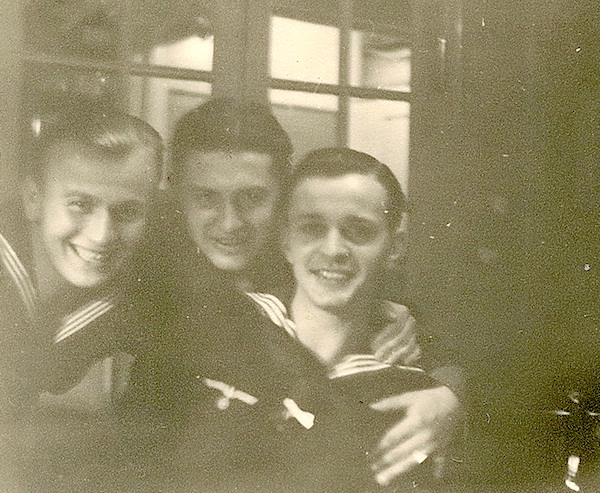
In their brief photographic annotations, these young men ask no questions. Their curiosity is limited mainly to the picturesque and the technical, to fun, or to brief war events: wrecked bridges, crashes, or bomb damage. Aside from those in the SS, they seem innocent of politics or ideology; doing what their commanders tell them needs doing. Only when 61 Division, and many others, are later redeployed to the Ostfront—to Poland (again), Lithuania, Latvia, Estonia, Ukraine, and Russia—or to Yugoslavia, Greece, and North Africa—will shadows pervade more of their images and notes. Frozen graves; brutal and merciless fighting; complicity in loss of innocence, integrity, and lives; destruction of their own and others’ souls, still lie beyond the horizon, unseen in the dim future.
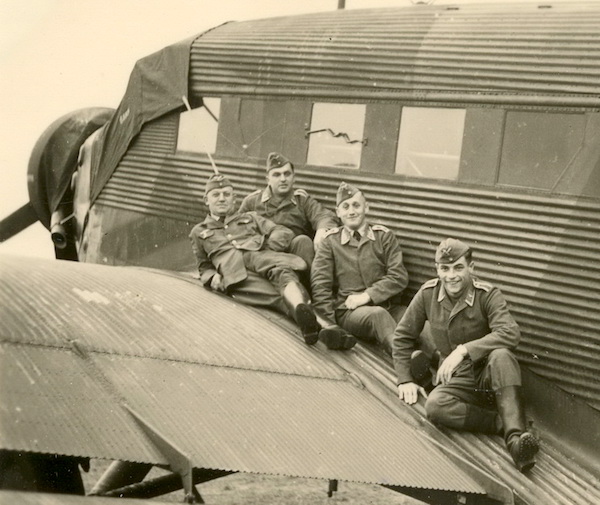
For now, they seem like so many very young men given a chance at something by military recruitment. They do not spend much time imagining the passage of time. They have a job to do with an army that seems unstoppable and must therefore be in the right; a modern army for a modern country, in contrast to the places they march through. They look to their generals more than to Hitler. They have pay, and sharp uniforms, and adventure awaits them. They entered their teenage years when Hitler was already in power, promising jobs, prosperity, and a return of national honor. The so-called “stab in the back” of Versailles, the civil war of 1918-20, the uncertain politics of the Republic, even the depths of the first three years of the Depression were things they heard about more than directly experienced.
We will come back to this confident modernism of the young in the next column. I believe that it was important both to their developing sense of racial or ethnic hierarchy, and thus to their later actions, and also to the consciousness of those Dutch who collaborated with the occupiers.

Exactly When and Where
Thanks to a couple of determined auction competitors, I almost lost this photo, and probably paid a little too much for it. Like many such online offerings, it came with a cryptic seller’s description and no provenance. It’s another small-format snapshot, printed on 1940s Gevaert Ridax paper, and likely taken with a modest 1930s-tech camera that struggled with distant figures in a grey dawn. But no matter. Show this photo to any Hollander of a certain generation, and they will know exactly when and where it was taken, and precisely what it depicts.
The arches that can be seen in the background belong to the Moerdijk rail bridge. At 1500 meters, it was at the time of its building the largest bridge in Europe, spanning the kilometer-wide Hollandsch Diep, part of the Maas (Meuse) estuary that effectively divided the main landmass of northeastern from southwestern Holland. By 1940, it had been twinned with a road bridge. The Dutch had fortified the southern end of both bridges, but had only lightly garrisoned the northern end, assuming in concert with military and neutrality doctrines of the time that an attack would come through France and Belgium.
But that plan did not take into account the possibility of a German drive westward through Holland toward Rotterdam and on to Antwerp. It also did not take into account the Fallschirmjäger; parachute troops under the command of Luftwaffe general Kurt Student, dropped ahead of the main body of the German advance to capture and hold strategic airfields and bridges.
On 10 May 1940, between 4:00 and 4:45 a.m., Stuka dive bombers assaulted the Dutch positions at the bridges, and shortly after, paratroops landed at both ends. Their objective was to hold the bridges until German land forces arrived from the south and east.
The battles that followed during that morning were uneven, often confused (on both sides), carried out mainly by small and often poorly-connected groups (again on both sides) and at times bitter. Some Dutch troops, in shock at the assault, surrendered quickly. Others fought on to the last. It has latterly been alleged by one or two historians that some Dutch troops, in a fury, directed fire not only at the Germans but at their own comrades who had been taken prisoner, judging them as “traitors” who gave up too easily.
The Germans managed to capture and hold both the road and rail bridges on May 10, and to ensure that the explosives the Dutch had installed in them were disarmed (in fact, the wiring for the charges had already been removed several months earlier by order of the former Dutch C-in-C, who was concerned that they might be set off “prematurely”). Three days later, the Dutch attempted an air attack to disable the bridges. The last airworthy T-5 medium bomber of the decimated Luchtvaart Brigade (Army Aviation Brigade) was loaded with two 1000-lb mine-bombs and, escorted by two G-1 heavy interceptors, made it to the bridges.
Under withering fire, the Dutch planes made two passes. The first resulted in a near-miss, the mine detonating in the water. On the second pass, the remaining bomb hit a glancing blow on a bridge abutment but failed to explode, as the detonation mechanism wasn’t sufficiently triggered. Amazingly, all three aircraft were then able to turn for home, but in airspace completely dominated by Germans, the T-5 and one of the G-1’s were shot down. Both crews perished.
In 1944, the Germans blew up the bridges to delay the Allied advance.
It is often taken as received wisdom that the parachute assaults on the Moerdijk bridges and the air landings at Valkenburg and other airfields near The Hague were key to the German takeover of Holland. This is false. The Moerdijk assault came close to defeat for the Germans, despite the insufficiency of the Dutch defenses. And the Valkenburg air landings were a failure. Intended to undertake an expedition to seize the nearby Dutch capital and kidnap the royal family, the German airborne troops were instead bottled up and never got farther than the village of Katwijk on the nearby coast.
Nevertheless, the myth of the lightning-fast and invincible forward air assault entered military doctrine, and photographs such as the one above became iconic of it. They influenced the planning of the Allied assault on Arnhem in 1944 . . . which also failed. The German invasion of the Netherlands succeeded ultimately through land warfare fought by mass armies. The Dutch C-in-C, Winkelman, installed just before the war, surrendered while the center of “Fortress Holland” still held, though cut off from French and British aid, and while a majority of Dutch soldiers still had not yet engaged the enemy. Wisely, he saw that continuing to fight in isolation for several more days, accepting the threat of another terror bombing like that of Rotterdam, could not alter the inevitable outcome, and would entail a horrendous cost.
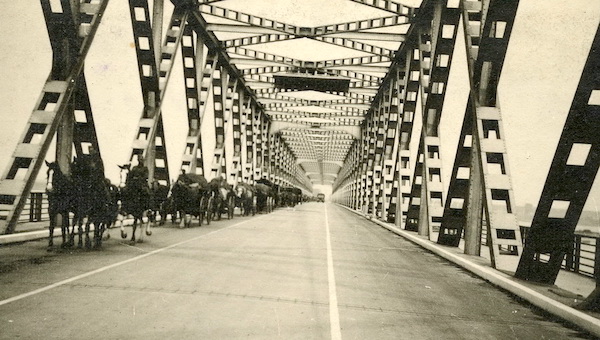
This is a shot of the Moerdijk road bridge, with a solitary German motorized vehicle in the far distance, and a long line of horse-drawn equipment and supplies stretching into the foreground. Such photos are instructive, given the bias of image buyers and sellers, and popular writers on war, to prefer the subject-matter of technology; especially charismatic technologies: bombers, fighters, tanks, big artillery, fast armored cars. Who would guess, given this bias, that of German aircraft in Dutch skies that May, the lowly Focke-Wulf 58 Weihe would be so ubiquitous, ferrying officers, orders, and maps to and fro, transporting wounded, spotting for ground troops or surveying terrain and shores? We forget that wars are won and lost more through logistics than the presence or absence of the fastest fighters or the most arcane “secret weapons.”
When I was in my teens, my father bought a dapple-grey riding mare for my sisters. He had attended a local riding school when young and had learned to ride cavalry-style: straight-backed and canted slightly forward, legs tensed, posting to the horse’s gait, holding the reins in one hand and crooking the other arm, elbow back, as if cradling a lance. When the mare arrived, he swung into the saddle and gave a demonstration of how to handle a horse. Nearly 30 years after his lessons, he was one with his mount. It happened that a neighbor dropped by at that moment, a German veteran who had emigrated to Canada after the war. Impressed, he turned to us and exclaimed, “Just like in the war! That was how we moved our supplies. All mit horses! All mit horses!”
The Hierarchy of the Stände
That being said, the next two images are of trucks. Those young invaders of May 1940 who were lucky enough to be assigned them, were proud of their LKW’s and photographed them often.
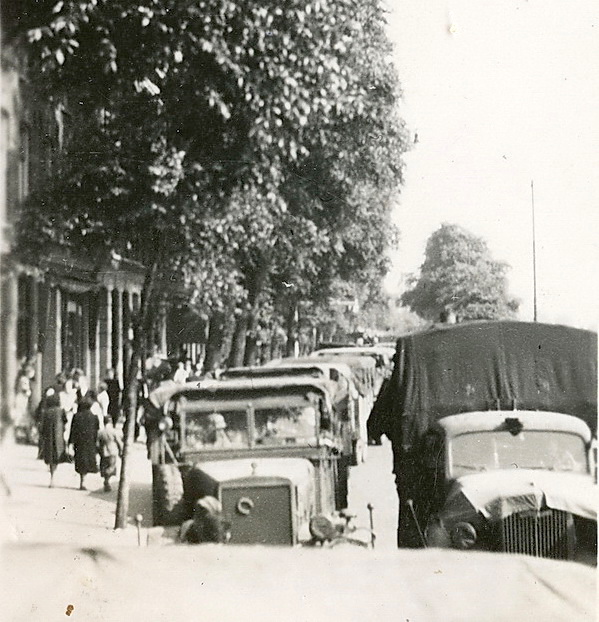
This image is a Velox print; a snapshot, so the seller assures me, of trucks belonging to the 33rd Panzer Regiment moving (I suspect slowly) through a street in Leiden—a city my father knew well as a boy. It gives me an odd chill to think that his 13-year-old self might have been only a kilometer or three removed from this scene.
The photographer clearly has stood up on the passenger side of the open cab of his truck to grab this shot. This gives it a retrospective sense: he has been where the trucks behind now are. There is a sense of a procession to this scene. Processions have long been ways in which European states and elites have demonstrated their power and their orders of rank: until the early modern period, the hierarchy of the Stände to which notables belonged was not confined to paper organizational charts but was demonstrated, in action, and in time, in the processional order: last in rank, last in time. This young photographer, perhaps out of unconscious cultural memory, was capturing his place and invoking the old gaze of precedence it made possible.
Note that the soldiers are helmeted: that tells me it is early days and they were still anticipating the possibility of military or “partisan” opposition. But this is in the middle of Fortress Holland, which saw only localized if bitter fighting before the capitulation. Perhaps that accounts for the fact that there are women and children out on the street. Did the whole affair seem a bit unreal to them?
There is a story, apparently true, about a Dutch soldier who boarded a Hague-bound tram on the first day of the invasion, to tell the passengers and conductor that the tram would, by order, be reversing direction to return whence it came because there was fighting ahead (at Valkenburg, Ockenburg, and Ypenburg airfields). He was berated by indignant civil servants among the passengers. They had work to do! Their offices awaited them!
How dare he reverse their precious time; the established order of their day?
European Holland had not seen war since the fall of Napoleon in 1815. Perhaps the shoppers on the sidewalk thought there might be bargains. Or that it might be time to stock up a little. It was a beautiful day to be outdoors, after all, one of a series of beautiful days that fateful first week of May. Perhaps they thought that all this war madness was happening at some abstract level above them and might soon pass. Or perhaps they are in some state of shocked suspension, mechanically going about their routine, the clock frozen.
Notwithstanding the shoppers’ seeming equanimity, Leiden had been close to intense fighting around Valkenburg airfield and at the Haagse Schouw bridge on the key A44 motorway. Dutch, British, and German bomber and ground-attack air units, the latter likely including Stukas, also struck nearby. A Stuka target would have been a pinprick relative to the area of a large city, unlike the mass carnage unleashed by a hundred Heinkels on Rotterdam. But up close it was devastating. Apparently. my father witnessed the human result of one air attack. But in his entire and very detailed memoir of the invasion days, there wasn’t a word about what he had seen in this instance. He spoke of it only once that I know of—to my mother only—and never again.
About the 33rd Panzers: there was a 33rd Panzer Regiment, but I believe the unit in the photo may be mislabeled (despite a pencil notation on the back affirming the identification), and was actually part of the 33 Infantry Division, which followed in the wake of the front-line forces, and didn’t see serious fighting until France.
One trivial note: what is with the horseshoe on the radiator grille of the truck behind the photographer’s? Its positional angle seems to break all the folk-rules for soliciting luck.
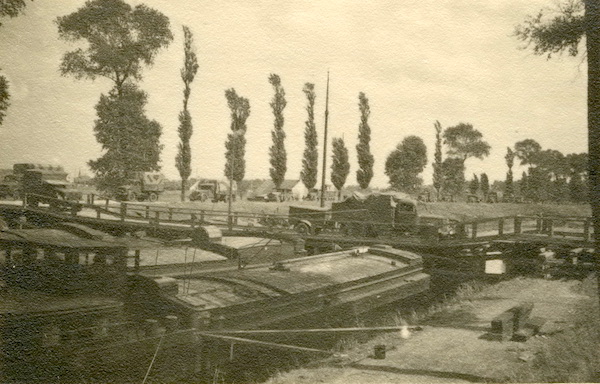
Focus first on the sky, and this could be a sepia print of a Hobbema painting from the 17th century. Until your eyes focus on the middle ground between the treetops and the sleeping barges in the foreground, and you see the line of trucks slowing to take a sharp bottleneck left on to the narrow bridge over the canal.
This is an Agfa print on matte card stock, still with a remnant paper hinge on the back where it was torn from someone’s album, likely by an estate buyer. The online seller identified the convoy as belonging to JG [Jagdgeschwader] 51, a Luftwaffe fighter wing that, like so many of these units, went on to fight in the Battle of France. And, again like so many others, then turned east to fight in Russia, then the Mediterranean, and then Russia again, in retreat. It surrendered on 8 May 1945, almost exactly five years after this photo was taken—in East Prussia, a jurisdiction that itself was about to cease existence. The photographer, one Voggel, is said to have served with this unit until at least 1941.
Again, this is a back-retrospective shot out of the cab of a truck that has made a dog-leg turn across the canal and is now accelerating away. Several other LKWs are still slowing to make that turn. There’s danger in this choke-point. The slowed vehicles would be sitting ducks for ground-attack aircraft. There was little chance of a pass by Dutch planes: those that remained were assigned to hot spots of combat. There were also RAF Blenheims on patrol, hastily sent by the British to aid the Dutch, though these quickly began to vie with Fairey Battles and Boulton-Paul Defiants for “most often shot down” status. Their distinctive tails jut out from smoking wreckage in many German photos taken during the Vormarsch into Belgium and France.
Bridge-crossing is an activity that anthropologists identify as liminal (from the Latin limen, or threshold).
Bridges can collapse, hurling those crossing them into waters that may drown them. But, more broadly, crossing a river by bridge or ferry, going to “the other side” calls up analogies to other transitions, to and from states of being; from known to unknown.
Think for example of Charon, in Greek and Roman mythology, the ferryman of the Styx, who conveys souls from the world of the living to that of the dead. Or the river Lethe in Hades, from which the souls of the dead must drink to forget their past lives.
The city of Leiden and its neighboring village of Leiderdorp got their names from a long-disappeared local stream via the derivatives Leithon or Leithen: in pre-medieval Germanic, leitha denoted a river subject to human modification (and thus possibly motivated to avenge itself on its tamers). Snapping a picture of the crossing, once crossed, could be a kind of unconscious cultural good-luck reflex.
Something Else Besides Tourists
Now, let’s follow some of these young men across the threshold from invasion to occupation. German forces stationed in Holland included not only those military units with a direct role in reinforcing the occupation, but also FLAK regiments who set up air defenses throughout the country; units staffing the bunkers of the Atlantikwall; Luftwaffe personnel who secured and operated the former Dutch military airfields for bomber crews who flew to attack North Sea shipping or targets in eastern England and Scotland; the fighter crews who accompanied them or who, from 1941 on, intercepted British and American fighter sweeps and bomber fleets returning the favor. There were also Kriegsmarine crews whose boats docked in Rotterdam and other Dutch ports.
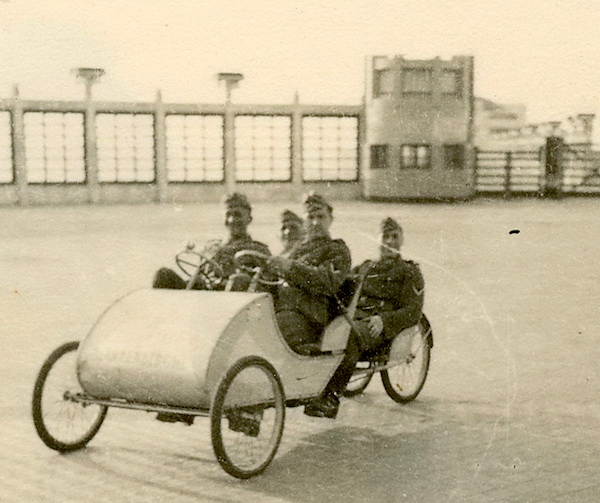
When they were not on active duty, these troops treated Holland in the first year or two of the occupation as a paradise to explore, populated by speakers of related languages with Germanic roots, whom they were told were racial siblings. They journeyed to the quaint villages of fisherfolk in Zeeland and on the IJsselmeer, jokingly trying on oilskins and affecting fishermen’s squat clay or brier pipes. They cavorted on the broad North Sea beaches of Scheveningen or, if the water was too cold, made for the baths there. They visited the old cities of the Seven Provinces, snapping photos of Leiden’s tall, iconic windmill, and of the Delft gatehouse painted by Vermeer. At Weesp, near Amsterdam, they treated the old Dutch fortifications as a sort of fairy castle.
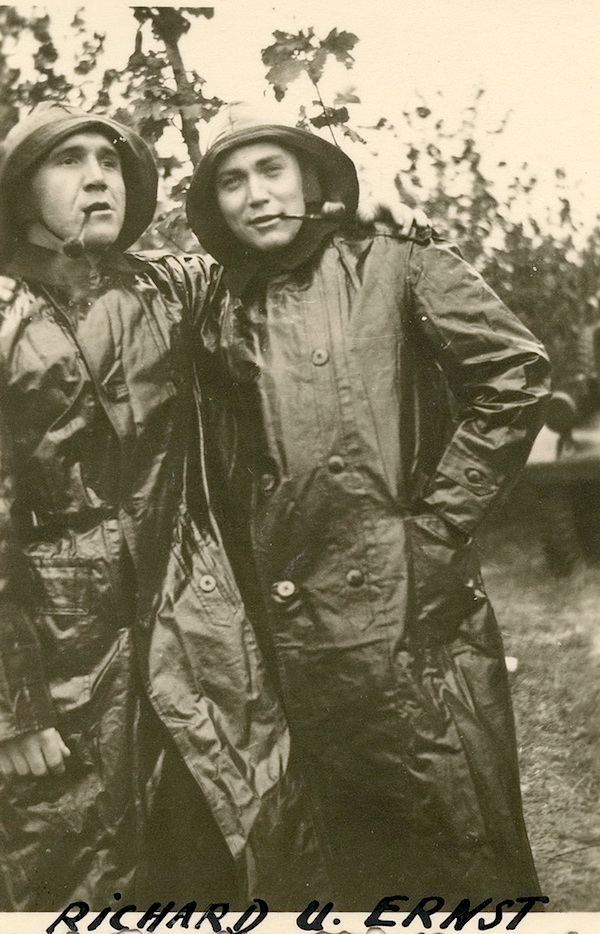
They drank beer and played games in the pubs and took photos of each other and the barkeep. In many ways, they anticipated the late-1950s mass-touristization of Holland and other European countries. They even took souvenir photos of the flattened city center of Rotterdam. They seem to have had little consciousness at first that to the Dutch they were something else besides tourists; that their freedom to tour and their schöne Zeit rested on subjection; that those Dutch they photographed might not all have felt they could say no; that the hospitality they enjoyed may have had a great deal to do with the ready money they spent initially rather than their amiability.
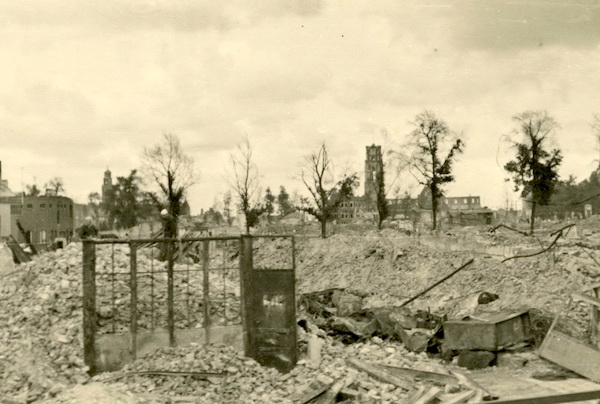
We could say that this lack of awareness evident in the composition of their photographs reflects no more than the crassness of young men in powerful armies of occupation anywhere. We could compare and contrast their images to snapshots taken by young men who hung out in bars before or between their missions or tours, in Da Nang or Saigon, Bangkok, Okinawa, or Guam.
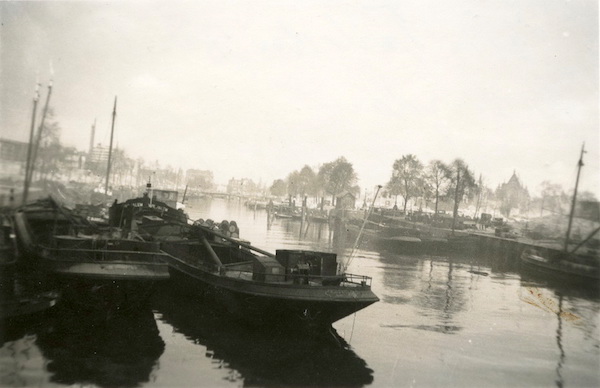
Certainly, there were Wehrmacht, Luftwaffe, or Kriegsmarine members who took care to compose images a cut above the usual tourist snap, like the unknown German who, knowingly or not, illustrated the principle that in photographing dramatic historical events, less is often more. In this image, said to be of Rotterdam on May 14, there are no ruins, only smoke drifting slowly over moored barges. Languid water belies the earlier seismic shudder of the bombs. The atmosphere conveys the doomed city better than a hundred hurried shots of destroyed buildings.
There was also a Luftwaffe doctor, a medic who took a series of well-composed, contemplative photographs across Holland in 1940-41. The dramatic portrait below, of an old Dutch fisher in the village of Marken, more respectful in tone than that of the play-acting boys above, may also be his.
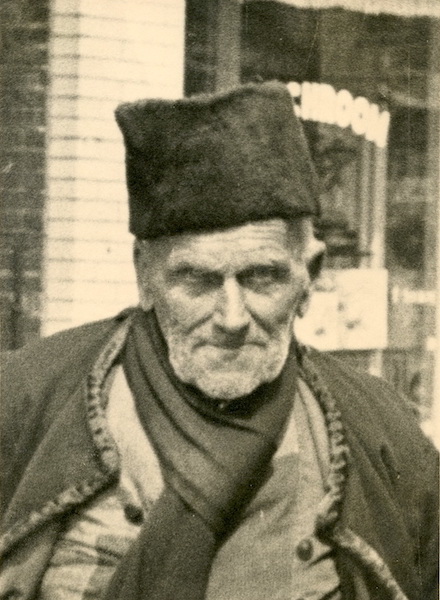
But these evocative images only sharpen a set of questions of which their photographers seemed oblivious. If the medic was sensitive enough to capture the soul of an elderly fisherman, how could he not see in that man’s eyes a hint that the army he was part of had just captured a nation? How could someone who took such dramatic pictures with sensitivity and a measure of respect have forgotten who he himself was in that moment?
Perhaps this is why I sensed that my curiosity about the points of view evident in German soldiers’ snapshots could lead me into dangerous places. In the expressive photo of the barges at Rotterdam, and of the old man in Marken, the photographers are absent. You, the viewer, are invited to take their place. You are invited to see a destroyed city as an evocative scene; as something sublime in the 18th-century sense of that term. You are invited to see the elderly fisher as an example of his Bevolkerung; a member of a quaint ethnic “population” stranded in a landlocked village by the onward march, the Vormarsch of modernity. You are invited to step into the photographer’s shoes and to see his subject as part of an anthropological gallery of Typen. Thereby, you are invited to forget who you are as you look.
And here is where things begin to go dark.
One last photo will serve to indicate the direction of this coming dusk. It was taken on a deceptively sunny day in 1940 or ’41, also in Marken, by a platoon leader from Bau-Bataillon 144. He and his on-leave friends stroll along behind two young women in traditional dress. He decides to snap a picture and captures one of the women hastily glancing behind her. He has the sloping sun at his back, a good position for a decent image, but the light bounces from the girl’s turned face back through the lens and blows out most of her features. The result is a blurred, generic scene: a quay bordered by quaint architecture, along which walk some village girls, one of whom coyly looks back and is in that instant frozen in time like Lot’s wife; her visage white as salt.
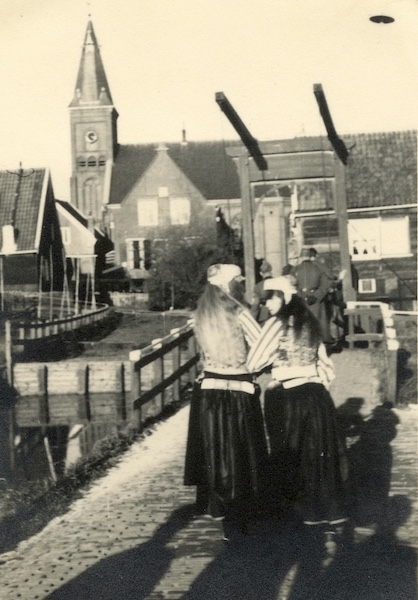
Is she coy, though? Or does her posture convey something else? Look down at the pavement in the foreground. When you see what ripples over it, do the Kameraden then become a palpable presence within the image? The photographer likely didn’t intend that effect, but once noticed, it’s hard to shake. These women are being shadowed.
If asked, the boys might have protested, “Nein, we areharmless, harmless! We are simply admiring diese schönen Mädchen!” But images escape their takers’ conscious intent. They become signifiers: fragments of evidence that register different denotative and connotative impacts in other circumstances. They embody their own punctum.
Roland Barthes described a photographic punctum as “that accident [of detail] which pricks me (but also bruises me, is poignant to me),” but added, “I now know that there exists another punctum (another ‘stigmatum’) than the ‘detail’; a new punctum which is no longer of form but of intensity; is Time, the lacerating emphasis of the noeme (‘that-has-been’), its pure representation.” [emphasis added]
In this instance, it manifests in a lacerating knowledge of what came between their then and our now.
Finally, consider two passages from Sontag’s On Photography that don’t quite match up with each other, though both are true. We will connect them next installment.
– The photographer is an armed version of the solitary walker reconnoitering, stalking, cruising . . . the voyeuristic stroller who discovers . . . a landscape of voluptuous extremes. Adept of the joys of watching, connoisseur of empathy, the flâneur finds the world ‘picturesque.’
– To suffer is one thing; another thing is living with the photographed images of suffering, which does not necessarily strengthen conscience and the ability to be compassionate. It can also corrupt them. Once one has seen such images, one has started down the road of seeing more – and more. Images transfix. Images anesthetize.”
[emphasis added]
My father once said that the average Wehrmacht soldier (like a B-B. 144 boy on a summer stroll through Marken Hafen) was just an ordinary person, no different from the average young Dutchman. By contrast, he added, the Gestapo and the SS were “crazy men” who enacted their ideological commitments to systematic excess, with the extreme cruelty that Hitler had called for in 1933.
I believed my father. He was my living authority on the era. But there was one thing I didn’t take into account in believing him: the possibility that, like the young Wehrmacht soldiers I have been discussing, he too might have drunk (unawares) from the Lethe and become victim to a particular kind of oblivion.
My father was right, you see. There was little difference between young Wehrmacht recruits and young Dutchmen like himself. I began this column still firmly believing him.
He may also have been very wrong. Wrong to suggest that there was a vast and unbridgeable difference between the cruel agents of the SS, the Gestapo or the Einsatzgruppen, and these ordinary young recruits—or by extension the sensitive medic-photographer of the Sanitaten, or even someone like himself or like me. Wrong also to phrase this observation in terms of personality types populated by individuals.
In my next column, I will consider such possibilities—from within. Within them there and then and, by grim analogy, also here and now.
![]()
Notes & References
“. . . suffering a quadruple infection of Unpünktlichkeit, Vorzeitigkeit, Verfrühtheit, Verspätung.”
– Unpünktlichkeit : Unpunctuality
– Vorzeitigkeit : Prematurity
– Verfrühtheit : Untimeliness
– Verspätung : Lateness; too late
“Winkelman . . . signed the capitulation of all Dutch forces in Europe, save for those Navy units which had escaped to Britain, Dutch troops still fighting in Zeeland on the Belgian border, and individual Dutch airmen who had crossed the Channel.”
– Dutch air, land, and sea forces in the Netherlands East and West Indies, and in Netherlands Guiana, remained under the command of the Dutch government-in-exile in London, headed by Queen Wilhelmina.
“. . . when the Dutch army fought desperately and unsuccessfully to turn back a neighbor who had come calling violently, without notice . . .”
– The “neighbor” reference is from Albert van der Mey, When a Neighbour Came Calling: Personal accounts of the Nazi occupation of the Netherlands, 1940-1945. Paideia Press, 1985.
– The Battle of the Netherlands is described reasonably well in the Wikipedia article, “German invasion of the Netherlands.”
– An in-depth treatment of the May Days in English may be found in Herman Amersfoort and Piet H. Kamphuis, eds., May 1940: The Battle for the Netherlands, vol. 57 in the series History of Warfare (Brill, 2010), though some of the content is problematic and has not been updated from a previous (1980’s) edition.
– Perhaps the best treatment in English at present is at the website, War Over Holland, http://www.waroverholland.nl/, maintained by an excellent amateur historian, Allert M.A. Goossens for the War Over Holland Foundation.
– See also the immense collection of NIOD Institute for War, Holocaust and Genocide Studies
– See also the Nederlands Instituut voor Militaire Historie (NIMH)
“. . . wrote a small, privately-printed memoir about them in his later years.”
– Willem Ramp (ed. W. J. Ramp), A Journey in the Shadow of Home: Holland 1927—Canada 1994. Peterborough Ontario, Canada, 1994. Copies (in Dutch) deposited with the FENIX Museum of Migration, Rotterdam, and het Leiderdorps Museum, Leiderdorp, ZH.
“. . . the final lines of a poem by Nina Kossman capture something . . .”
– N. Kossman, “Medals, etc.” in Sreda, 18 July 2020. https://www.sreda1.org/post/sreda14-kossman?fbclid=IwAR0jpF_D1T9JfER_wXMve12CAauOH2GHezfBNraqo-f80ddtbeMnwhmvtbc
“. . . or the question of an uncle I’d been close to: “Why would you bother with the point of view of invaders or traitors?”
– One might also ask why I don’t collect photos taken by the Dutch? There are three reasons. First, there are no such photos in my family collection, and I suspect they are absent from many Dutch family collections. Even at the beginning of the occupation, photographing out of doors was a risky thing for a citizen of an invaded country to do. Second, there are few such photos available to buy on the affordable (to me) “collectibles” market. And third, many photos that were taken by the Dutch are now published in various places, online and off, including by the formidable NIOD Institute for War, Holocaust and Genocide Studies (formerly Nederlands Instituut voor Oorlogsdocumentatie).
“I began to learn a new vocabulary of military movement and mechanized destruction:”
– Absturz : crash
– Angriff : attack
– Bau-Bataillon: Construction battalion
– Bevölkerung: population, populace, often used in an ethnic or racialized sense
(In relation to subject-matter of images discussed here, often connotes ethnic particularity)
– Brennende: burning
– Einsatz: deployment, operation, commitment
(used as a euphemistic connotative prefix in Einsatzgruppen: “special” operational groups).
– Flugzeugwrack: aircraft wreck
– Geschossen: shot; shot down
– Gesprengte brücke: blown-up bridge
– Hafen: harbour
– LKW: Lastkraftwagen, a generic term for a truck or lorry
– Mädchen: girl or girls, young woman/women
(sing. or pl. depending on preceding article: das, des, dem versus die, der, den)
– Musikkonzert: musical concert
– Rast: rest, rest period, pause
– Schöne zeit: beautiful time or period
(often inflected by nostalgia)
– Stahlhelm: The standard bucket-shaped steel helmet of the Wehrmacht.
– an Strand: at the beach
– Tanz: dance
(in the context of the soldiers’ photos referred to here, often connotes ethnic dance)
– Trinken: drinking
– Vormarsch: advance; to move forward, as in military movement
(A masculine noun. In relation to images discussed here, connotes invasion or conquest)
– Zerbombt: bombed
– Zerstörte: destroyed
“Those Wehrmacht troops lucky enough to pull occupation duty in the Netherlands for a year or two will remember it as die schöne Zeit . . .”
– The initial purpose of the occupation was military and tactical: to deny the coast, its harbours, and Dutch airfields, to the Allies. For much of the Dutch population not (yet) on arrest lists, the first few weeks or months of occupation seemed more like an administrative reshuffle, especially as the Dutch police and municipal governments were initially left in place. The occupation authorities also employed a “hearts and minds” strategy to win over these ‘racial cousins’, hosting events such as band concerts and football games pitting Dutch against Wehrmacht or Luftwaffe teams. Only in 1941 did Arthur Seyss-Inquart, Reichskommissar for the occupied Netherlands, begin to show his fanatical colors through a dual strategy of repression and a racial politicization of everything, “right down to the chessplayer’s club.”
“. . . the hierarchy of the Stände to which they belonged was not confined to paper organizational charts but was demonstrated, in action, and in time, in the processional order . . .”
– See Robert Darnton, “A Bourgeois Puts His World in Order: The City as a Text,” in Darnton, The Great Cat Massacre, and other episodes in French cultural history, Perseus Books, 2009.
“Or that it might be time to stock up a little.”
– A colleague, who had relatives in Leiden in 1940 (they told few stories about it after) remarked, “You just want to reach into the photo and beg them to buy up all the food they can.” Food would become a desperate necessity in the hunger winter of 1944-45, when German-occupied Holland was cut off from supplies by Allied encirclement.
“. . . the onward march, the Vormarsch of modernity.”
– I will have more to say about this topic in future columns. In relation to it, I highly recommend two books by Latvian-Canadian historian Modris Eksteins: Rites of Spring: The Great War and the Birth of the Modern Age, Houghton Mifflin, 1989), and Walking Since Daybreak: A Story of Eastern Europe, World War II and the Heart of Our Century, Houghton Mifflin, 1999.
“. . . and with the extreme cruelty that Hitler had called for in 1933.”
“I want a brutal, domineering, fearless, cruel youth. Youth must be all that. It must bear pain. There must be nothing weak and gentle about it. The free, splendid beast of prey must once again flash from its eyes. That is how I will create the New Order.” (Adolf Hitler, speaking at a youth rally, 1933)
“Roland Barthes wrote that “a photograph’s punctum is . . .”
Roland Barthes, Camera Lucida: Reflections on Photography, tr. R. Howard (New York: Hill & Wang, 1981): 27, 96. Selected and slightly rearranged by P. Schmid, at http://www.swarthmore.edu/Humanities/pschmid1/array/instant.relatives/b%2Bb.html , and with further emphasis and a parenthetical insertion by the author.
“Finally, consider two passages from Sontag’s On Photography . . .”
– Susan Sontag, On Photography (New York: Farrar, Straus and Giroux, 1977)
![]()
Images/Credits
Image 1
From Wikimedia Commons.
Subject: Project Brandgrens in Rotterdam, 15 May 2007. Photographer/author: Oscar
Licensing: Published by author under the following license:
– GNU Free Documentation License, Version 1.2 or any later version published by the Free Software Foundation; with no Invariant Sections, Front-Cover Texts, or Back-Cover Texts.
Also published on Wikimedia under the following licenses:
– Creative Commons Attribution-Share Alike 3.0 Unported license.
– Creative Commons Attribution 2.5 Generic license.
Image 2
From Wikimedia Commons
Description: Rail embedded in Churchyard, left as memorial to World War 2.
Date: 5 May 2020. Author/photographer: Nickuae
Published by author under Creative Commons Attribution-Share Alike 4.0 International license.
Image 3
From Wikimedia Commons
Description: The ruins of [Dresden] in 1945. Facing south from the town hall (“Rathaus”) tower. Statue “Güte” (“Good” or “Kindness”) by August Schreitmüller, 1908-1910.
Photographer: Richard Peter (1895–1977). Photograph title: Allegorie der Güte (auch: Bonitas)
Original image description from Deutsche Fotothek: Dresden. Blick vom Rathausturm nach Süden mit der Allegorie der Güte (auch: Bonitas; Skulptur von August Schreitmüller, entstanden 1908/1910), Aufnahme 1945. Date taken: between 17 September and 31 December, 1945
Source collection: Deutsche Fotothek. Blue pencil.svg wikidata:Q655507.
Accession number: df_ps_0000010
Licensing information: Provided to Wikimedia Commons by the Deutsche Fotothek of the Saxon State Library / State and University Library Dresden (SLUB) as part of a cooperation project. The Deutsche Fotothek guarantees an authentic representation only by using copies of the original images as provided by the Digital Image Archive
Image 4
From Wikimedia Commons
Caption (English): The Fokker G.I was a Dutch twin-engined heavy fighter aircraft comparable in size and role to the German Messerschmitt Bf 110. Although in production prior to World War II, its combat introduction came at a time the Netherlands were overrun by the Germans.
Date: 8 April 2020. Author and copyright: Ad Meskens(scan), own work.
This picture may be used for any purpose as long as credit is given to its author, Ad Meskens.
Example: © Ad Meskens/Wikimedia Commons
Image 5
Author’s collection.
Image 6
From Wikimedia Commons.
Description (English): Henri Gerard Winkelman (1876-1952) was a Dutch military officer who served as Commander-in-chief of the Armed Forces of the Netherlands from February 5, 1940 till May 15, 1940. Date of photograph: c. 1934. Source: www.tracesofwar.nl. Author: Unknown.
Licensing: This work is in the public domain in its country of origin and other countries and areas where the copyright term is the author’s life plus 70 years or fewer.
Images 7 to 9
Author’s collection.
Image 10
As reproduced here, this image is from a photograph in the author’s collection, which appears to have been printed at a time roughly contemporary with the events portrayed.
However, I have located identical or near-identical images in two other locations, as follows:
1) Published on page 344 of H. W. Van Den Doel, “Not A Bridge Too Far: The Battle For The Moerdijk Bridges, Dordrecht And Rotterdam,” in Herman Amersfoort and Piet H. Kamphuis, eds., May 1940: The Battle for the Netherlands, vol. 57 in the series History of Warfare (Brill, 2010). It is there credited to one “H. Winters.” The author has reveived permission from Brill to reproduce this particular image in a future Weekly Hubris column.
2) In the image bank on the website of the NIOD Institute for War, Holocaust and Genocide Studies, where its contextual information is given as follows:
Image no.: 131917. Collection: Verzetsmuseum Zuid-Holland
Keywords: Bruggen (bridges), Parachutisten (parachutists or paratroops). Location: Netherlands.
Caption: German airborne landings May 10, 1940 near Moerdijk
In a future column on this topic in Weekly Hubris, I will compare the nature and provenance of these three images.
Images 11 to 19
Author’s collection.
![]()
Acknowledgments
I wish to acknowledge Dr. D. DesRoches, Dr. H. Van Den Doel, Allayna Ramp, and Dr. Karen Wall for their comments, ideas, and assistance. And also the memory and insights of my father, Willem (Wim) Ramp, and my mother Ruth (Duncan) Ramp.


One Comment
William Ramp
In addition to the acknowledgements above, I wish also to thank Elizabeth Boleman-Herring for her always graceful and patient editorial work, and Jeanne and Peter Van Den Hurk of Clemson University for expert editing (especially for catching my habitual reversals of North, south, east & west, and for pointers on German orthography).